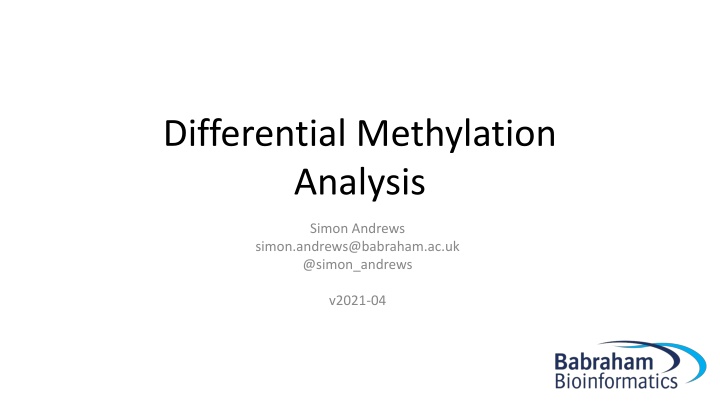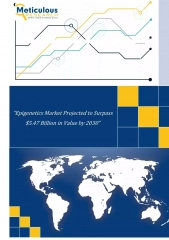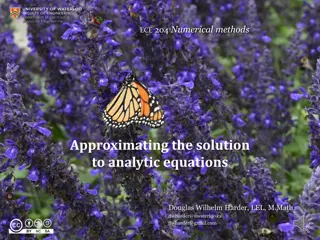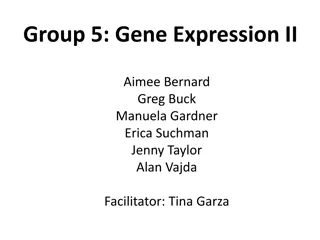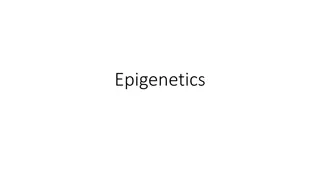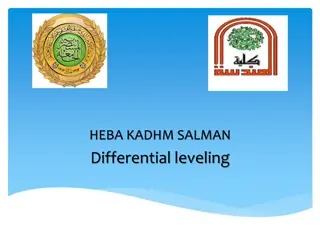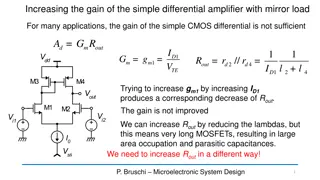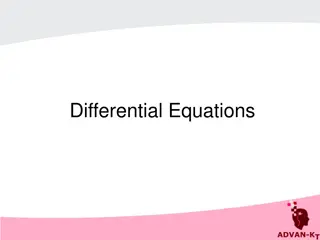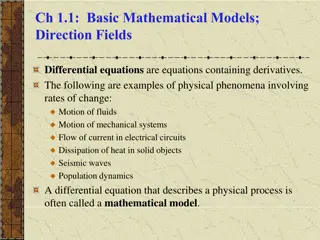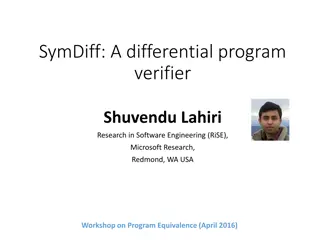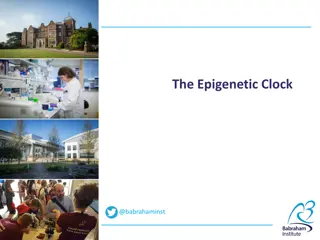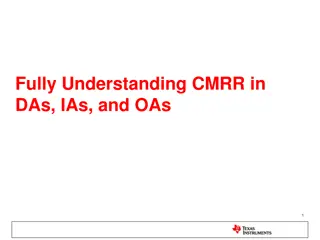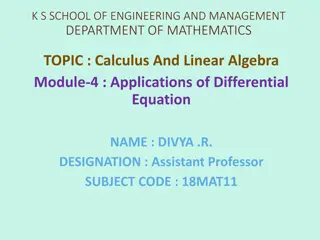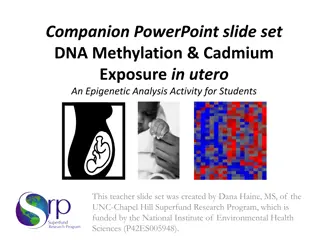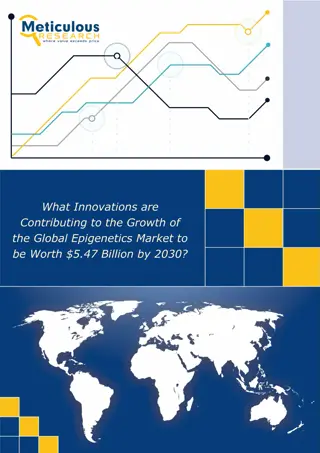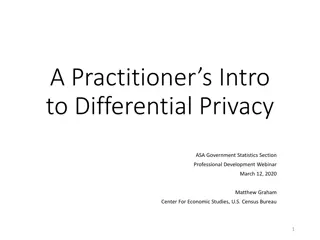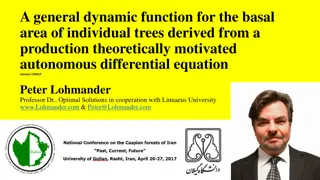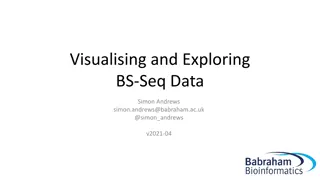Strategies for Differential Methylation Analysis in Epigenetics Research
Explore the process of differential methylation analysis through raw data handling, statistical power assessment, and correction considerations. Learn how to identify significant changes in methylation levels and address challenges like global differences and statistical power in epigenetic research.
Download Presentation

Please find below an Image/Link to download the presentation.
The content on the website is provided AS IS for your information and personal use only. It may not be sold, licensed, or shared on other websites without obtaining consent from the author.If you encounter any issues during the download, it is possible that the publisher has removed the file from their server.
You are allowed to download the files provided on this website for personal or commercial use, subject to the condition that they are used lawfully. All files are the property of their respective owners.
The content on the website is provided AS IS for your information and personal use only. It may not be sold, licensed, or shared on other websites without obtaining consent from the author.
E N D
Presentation Transcript
Differential Methylation Analysis Simon Andrews simon.andrews@babraham.ac.uk @simon_andrews v2021-04
Two Strategies Raw Data Reverse Counting Normalised %methylation Counts of Meth/Unmeth Continuous value statistics Count based statistics
Factors to consider Formulating a sensible question Applying corrections if needed Assessing statistical power Relating hits to biology
Question Which areas show a significant change in methylation level between the two conditions?
Question Which areas show a change in methylation which is larger or smaller than the global change in the samples overall?
Question Which areas show a change in methylation after correcting for the small global differences?
Count Data Meth Unmeth Sample 1 Sample 2 18 5 10 20 Is the difference in ratios significant given the observation levels of the samples
The problem of power Ideally want to cover every Cytosine (CpG) Should correct for the number of tests It s unlikely you ll collect enough data to analyse each C and have p-values which survive multiple testing correction Generally need to analyse in windows
Window sizes Effect size Small Large Good resolution Specific biological effects High MTC burden Small observations High p-values Lots of data High statistical power Low MTC burden Low p-values Effect averaging
Power Analysis (Assuming a human genome with p<0.05 and power of detection of 0.8) Window Size (# CpG cytosines) 1 10 25 5419 232 63 18 4 50 2609 112 30 9 2 100 1254 54 15 5 1 200 602 26 7 2 1 500 228 10 3 1 1 1 5 10 20 50 158805 6794 1825 509 94 14212 608 164 46 9 Absolute methylation change (from 80%) Required Fold Genome Coverage 1 10 2559 110 30 9 2 25 1024 44 12 4 1 50 512 22 6 2 1 100 256 11 3 1 1 200 128 6 2 1 1 500 52 3 1 1 1 Without Multiple Testing Correction 1 5 10 20 50 25583 1094 294 82 15
Contingency Statistics are simple to use for differential methylation in well behaved data Unreplicated Chi-Square Fisher s Exact
Contingency Statistics are simple to use for differential methylation in well behaved data Replicated Contingency - Logistic Regression Linear Modelling of counts - EdgeR
Binomial statistics can find interesting points in globally changing datasets Changes the default expectation Find average difference for each starting point Select points which exhibit unusual change
Globally changing example Starting level = 30% Observations = 14 meth 6 unmeth Expected End level = 85% Binomial test, p=0.85, trials=20, successes=14 Raw p=0.106
Beta Binomial Models What is the probability distribution for the true methylation level? Simple model: Binomial stats to estimate confidence Can we do better? Genome-wide methylation profile. All levels are not equally likely Can inform the construction of a Custom beta binomial distribution
Beta-binomial model Measure 3/20 observations as methylated The binomial distribution would be defined by the mean and observations Using the whole genome prior a beta-binomial model would upweight the lower methylation levels, since these are more common. Provides increased power in comparisons between major groups Often computationally intensive
Limitations of count based stats No subdivision of calls all calls are equal even when coverage isn t Supplement with differences based on better quantitation Potential biased by power Can alleviate with CpG window based analysis Easy to bias data otherwise Problem of interpretation, not statistics
BSmooth algorithm for methylation correction black: 25x (Lister) pink: 4x (Lister)
Normalisation for methylation levels Original Levels Single Correction Quantile Normalisation
Statistics Standard continuous statistics T-Test ANOVA Information sharing continuous stats LIMMA Reduced power one value per replicate
Reverse counting Some packages offer a conversion from normalised methylation back to counts True observations: Meth=20 Umeth=30 (40% meth) Corrected % methylation = 50% Reversed counts: Meth=25 Unmeth=25 Allows count based statistics regains the lost power from normalisation Retains information about noise from the true observation level
Reverse counting of normalised data can give very different results
Reverse counting of normalised data can give very different results
Look for hit clusters Grouping to create larger candidate regions Check intermediate regions for consistency
Patterning of hits may suggest more specific ways to quantitate and analyse.
Biological considerations Minimum relevant effect size? Balance power vs change What makes biological sense (what would you follow up?) Position relative to features Consistent change over adjacent regions
Methylation statistics packages SeqMonk (Graphical Analysis Package) Flexible measurement based on fixed windows, fixed calls or features. Complex corrected methylation calculation and several optional post-calculation normalization options. Chi-Square with optional resampling for unreplicated data, logistic regression with optional resampling for replicated data. EdgeR (R-package by Gordon Smyth) Originally designed for count data (RNA-Seq mostly), there is now a mode which models paired counts for meth/unmeth to provide differential methylation statistics. Stats are based around negative binomial linear models. methylKit (R-package by A. Akalin et al.) Sliding window, Fisher s exact test or logistic regression. Adjusts p-values to q-values using SLIM method. bsseq (R/Bioconductor by K.D. Hansen) Implements the BSmooth smoothing algorithm. Numerous CpG-wise t-tests and p-value cutoff to define DMRs. Outperforms Fisher s exact test. Requires biological replicates for DMR detection BiSeq (R/Bioconductor by K. Hebestreit et al.) Beta regression model, impractical for very large data other than RRBS or targeted BS-Seq MOABS (C++ command line tool by D. Sun et al.) Beta binomial hierarchical model to capture sampling and biological variation, Credible Methylation Difference (CDIF) single metric that combines biological and statistical significance
